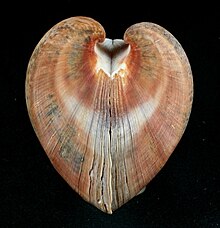
The beak is part of the shell of a bivalve mollusk, i.e. part of the shell of a saltwater or freshwater clam. The beak is the basal projection of the oldest part of the valve of the adult animal. The beak usually, but not always, coincides with the umbo, the highest and most prominent point on the valve. Because by definition, all bivalves have two valves, the shell of a bivalve has two umbones, and two beaks.[1]
In many species of bivalves the beaks point towards one another. However, in some species of bivalves the beaks point posteriorly, in which case they are referred to as opisthogyrate; in others the beaks point forward, and are described as being prosogyrate.
If the beak is not eroded or worn down at all, it may still be capped with the prodissoconch, which is the larval shell of the animal.
References
[edit]- ^ Hatterlie, Eugene C.; Abbott, Donald P. (1980). "15: Bivalvia: the clams and allies". Intertidal Invertebrates of California. Stanford University. p. 356. ISBN 978-0-8047-1045-9.
Well, that’s interesting to know that Psilotum nudum are known as whisk ferns. Psilotum nudum is the commoner species of the two. While the P. flaccidum is a rare species and is found in the tropical islands. Both the species are usually epiphytic in habit and grow upon tree ferns. These species may also be terrestrial and grow in humus or in the crevices of the rocks.
View the detailed Guide of Psilotum nudum: Detailed Study Of Psilotum Nudum (Whisk Fern), Classification, Anatomy, Reproduction